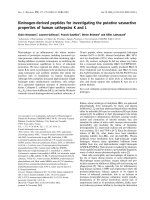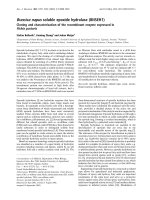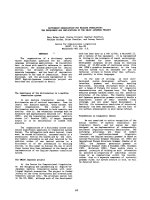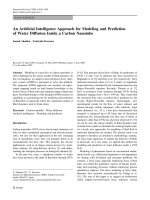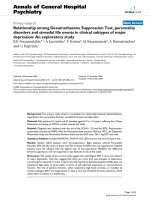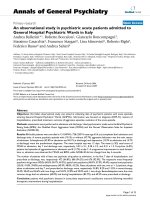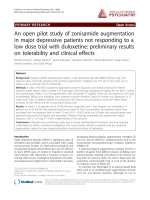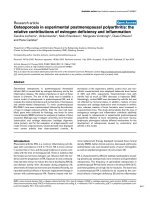Báo cáo y học: "An in vitro study investigating the survival and phenotype of mesenchymal stem cells following injection into nucleus pulposus tissue" pot
Bạn đang xem bản rút gọn của tài liệu. Xem và tải ngay bản đầy đủ của tài liệu tại đây (5.15 MB, 10 trang )
Open Access
Available online />Page 1 of 10
(page number not for citation purposes)
Vol 11 No 1
Research article
An in vitro study investigating the survival and phenotype of
mesenchymal stem cells following injection into nucleus pulposus
tissue
Christine L Le Maitre
1
, Pauline Baird
2
, Anthony J Freemont
2
and Judith A Hoyland
2
1
Biomedical Research Centre, Biosciences, Faculty of Health and Wellbeing, Sheffield Hallam University, City Campus, Owen Building, Howard
Street, Sheffield S1 1WB, UK
2
Tissue Injury and Repair Group, School of Clinical and Laboratory Sciences, Faculty of Medical and Human Sciences, Stopford Building, The
University of Manchester, Oxford Road, Manchester M13 9PT, UK
Corresponding author: Judith A Hoyland,
Received: 24 Sep 2008 Revisions requested: 30 Oct 2008 Revisions received: 14 Jan 2009 Accepted: 11 Feb 2009 Published: 11 Feb 2009
Arthritis Research & Therapy 2009, 11:R20 (doi:10.1186/ar2611)
This article is online at: />© 2009 Le Maitre et al.; licensee BioMed Central Ltd.
This is an open access article distributed under the terms of the Creative Commons Attribution License ( />),
which permits unrestricted use, distribution, and reproduction in any medium, provided the original work is properly cited.
Abstract
Introduction The decreased disc height characteristic of
intervertebral disc (IVD) degeneration has often been linked to
low back pain, and thus regeneration strategies aimed at
restoring the disc extracellular matrix and ultimately disc height
have been proposed as potential treatments for IVD
degeneration. One such therapy under investigation by a
number of groups worldwide is the use of autologous
mesenchymal stem cells (MSCs) to aid in the regeneration of
the IVD extracellular matrix. To date, however, the optimum
method of application of these cells for regeneration strategies
for the IVD is unclear, and few studies have investigated the
direct injection of MSCs alone into IVD tissues. In the present
article, we investigated the survival and phenotype of human
MSCs, sourced from aged individuals, following injection into
nucleus pulposus (NP) tissue explant cultures.
Methods Human MSCs extracted from bone marrow were
expanded in monolayer culture and, after labelling with
adenoviral vectors carrying the green fluorescent protein
transcript, were injected into NP tissue explants (sourced from
bovine caudal discs) and maintained in culture for 2, 7, 14 and
28 days post injection. Following fixation and paraffin
embedding, cell viability was assessed using in situ
hybridisation for polyA-mRNA and using immunohistochemistry
for caspase 3. Immunohistochemistry/fluorescence for
aggrecan, Sox-9 and types I, II and X collagen together with
Alizarin red staining was employed to investigate the MSC
phenotype and matrix formation.
Results MSCs were identified in all injected tissue samples and
cell viability was maintained for the 4 weeks investigated. MSCs
displayed cellular staining for Sox-9, and displayed cellular and
matrix staining for aggrecan and type II collagen that increased
during culture. No type I collagen, type X collagen or Alizarin red
staining was observed at any time point.
Conclusions MSCs from older individuals differentiate
spontaneously into chondrocyte-like NP cells upon insertion into
NP tissue in vitro, and thus may not require additional
stimulation or carrier to induce differentiation. This is a key
finding, as such a strategy would minimise the level of external
manipulation required prior to insertion into the patient, thus
simplifying the treatment strategy and reducing costs.
Introduction
Approximately 11 million people in the UK experience low
back pain (LBP) for at least 1 week each month, leading to a
considerable loss of working days and significantly impacting
on the National Health Service [1,2]. The causes of LBP are
multifactorial but the role of intervertebral disc (IVD) degener-
ation per se in LBP is becoming clearer [3]. Imaging studies
indicate a link between IVD degeneration and LBP [3,4], with
the most clinically significant correlations between degenerate
disc space narrowing (which develops as degeneration
progresses [5,6]) and chronic LBP [7]. A key target for the
treatment of LBP is therefore the restoration of disc height,
Ad-GFP: adenoviral vectors carrying the green fluorescent protein transcript; DMEM: Dulbecco's modified Eagle's medium; FCS: foetal calf serum;
GFP: green fluorescent protein; IL: interleukin; IVD: intervertebral disc; LBP: low back pain; MSC: mesenchymal stem cell; NP: nucleus pulposus;
PBS: phosphate-buffered saline; PG: proteoglycan.
Arthritis Research & Therapy Vol 11 No 1 Le Maitre et al.
Page 2 of 10
(page number not for citation purposes)
which could be achieved via the regeneration of the extracel-
lular matrix in the degenerate IVD.
Evidence from studies investigating the pathogenesis of IVD
degeneration illustrates that IVD degeneration originates from
the nucleus pulposus (NP), where both type II collagen and
proteoglycan synthesis and content decrease [8,9], thus the
NP is the area of the disc that is targeted by a number of
groups worldwide for regeneration strategies [10,11]. Numer-
ous methods are under investigation to stimulate regeneration
of the disc, including growth factor treatments and cell-based
therapies which either utilize cells alone or combined with
scaffolds [12]. A cell source that has been suggested for such
therapies is that of autologous disc cells harvested from adja-
cent nondegenerate discs, although removal of cells from a
donor disc can induce degeneration, and thus would be
unsuitable [13]. Other studies have suggested using autolo-
gous degenerate IVD cells extracted during discectomy,
which following in vitro expansion would be reinserted into the
degenerate IVD [14,15]. We have previously shown, however,
that cells derived from a degenerate IVD show a senescent
phenotype [16,17], which results in a reduced cell replication
potential, and thus the expansion capabilities of degenerate
IVD cells are limited. Furthermore we have shown that IVD
cells derived from a degenerate disc display an abnormal phe-
notype, with increased catabolic and decreased anabolic
activity, and thus are not the ideal cell type to stimulate regen-
eration, and indeed could even lead to accelerated degenera-
tion of the treated IVD [18-24].
An alternative cell source are adult stem cells, in particular,
bone-marrow-derived mesenchymal stem cells (MSCs). The
use of these cells would allow an autologous approach, reduc-
ing the risk of rejection and infection. MSCs are multipotent,
and have the ability to differentiate into an NP-like phenotype
when appropriately stimulated [25-29]. To date, however, the
optimum method of application of these cells for repair/regen-
eration strategies for the IVD is unclear. A number of studies
have described the development of tissue-engineered gels
and scaffolds seeded with MSCs to assist in the regeneration
of the IVD [10], and have shown promising results in vitro. Yet
it is unclear whether a scaffold would be required to assist in
tissue regeneration or whether the in vivo tissue niche and/or
local cells alone are sufficient to stimulate appropriate MSC
differentiation.
Work from our laboratory has shown that co-culture of MSCs
with NP cells in vitro is capable of inducing differentiation to
an NP-like phenotype [26]. This raises the possibility that the
native IVD cells in vivo could induce MSC differentiation with-
out the need for external manipulation. Such an approach
would be of great benefit for mild and moderate stages of
degeneration and could also be useful as a preventative strat-
egy following disc surgery to adjacent IVDs to prevent the
accelerated degeneration often seen within these discs. A
recent study by Ho and colleagues also suggests that MSC
injection therapies may show potential at late stages of degen-
eration [30]. Treatment at this stage would, however, in all like-
lihood require some form of combined therapy utilising an
appropriate scaffold to provide support to the cells and restore
IVD height immediately whilst the matrix is formed. Addition-
ally, such strategies would probably require combined treat-
ments to restrain the degenerative processes – such as
inhibition of IL-1, which is significantly increased in IVD degen-
eration and has been shown to be involved in matrix degrada-
tion [18,31].
Interestingly only a limited number of studies have investigated
the injection of MSCs into IVDs, and, although these have
demonstrated cell survival and increased proteoglycan (PG)
production within the IVD [28,30,32-36], few have investi-
gated the phenotype of the injected stem cells. Sakai and col-
leagues investigated the injection of rabbit MSCs, within an
aetocollagen gel, into the rabbit disc, and demonstrated that
the MSCs differentiated to a chondrocyte-like phenotype and
increased the collagen and PG content within the disc [28].
Whether the carrier gel was responsible for inducing MSC dif-
ferentiation, however, was unclear. More recently Hiyama and
colleagues directly injected MSCs into a canine degenerate
disc model; although the study tracked the MSCs, only Fas lig-
and expression and overall PG production was assessed and
the authors did not determine whether the injected MSCs dis-
played appropriate differentiation and phenotype [36]. Impor-
tantly, no studies to date have investigated the phenotype of
human MSCs following injection into IVD tissue.
In the present article we established an in vitro model system
to investigate the survival and phenotype of human MSCs fol-
lowing injection into bovine NP tissue explants to test the fol-
lowing hypothesis: that the IVD tissue niche itself can induce
the differentiation of MSCs to a disc-like phenotype and direct
the cells to form a new and appropriate matrix.
Materials and methods
Mesenchymal stem cell source and extraction
Bone marrow samples were received from two patients (aged
66 and 74 years) undergoing hip replacements. Informed con-
sent from the patients and local ethical committee approval
were obtained. Bone marrow was negatively sorted for hae-
matopoietic cells using RosetteSep (STEMCELL Technolo-
gies SARL, Grenoble, France) prior to isolation of
mononuclear cells using a Histopaque 1077 gradient (Sigma,
Poole, UK). Cells were cultured for 7 days and any nonadher-
ent cells were removed. MSCs (characterised by their adher-
ence to plastic and morphology) were then expanded in a
monolayer and used at low passage (passage < 2). The
multipotentiality of these MSCs was assessed via differentia-
tion along the three common mesenchymal lineages (osteo-
genic, adipogeneic and chondrogenic) using standard
methodology.
Available online />Page 3 of 10
(page number not for citation purposes)
Nucleus pulposus tissue explant culture
Bovine tails from 9-month-old to 18-month-old cows were
obtained from the abattoir. Caudal IVDs were excised and NP
tissue was isolated. Cores of NP tissue (0.5 cm in diameter
and 0.6 cm high) were formed and placed into a Perspex ring
culture system as described previously [37]. DMEM + F12
media supplemented with 10% v/v heat-inactivated FCS
(Gibco, Paisley, UK), 100 U/ml penicillin (Sigma, Poole, UK),
100 μg/ml streptomycin (Sigma), 250 ng/ml amphotericin, 2
mM glutamine (Sigma) and 50 μg/ml ascorbic acid (Sigma)
(complete cell culture media) was applied and tissue explants
were maintained in culture for 1 week prior to MSC injection.
Cell labelling
To allow cell tracking following cell injection, the MSCs were
infected with adenoviral vectors carrying the green fluorescent
protein transcript (Ad-GFP). The optimal multiplicity of infec-
tion was determined as 1,000, which resulted in 100% infec-
tivity without cytotoxic effects (data not shown). To perform
infection, MSCs in a monolayer culture were typsinised from
flasks, cell counts were performed and then cells were re-
seeded into T75 flasks in 5 ml complete media and were
allowed to adhere for 4 hours. Following adherence of MSCs,
an appropriate volume of Ad-GFP (Vector Biolabs, Philadel-
phia, PA, USA) was applied to achieve a multiplicity of infec-
tion of 1,000 and was left for 2 hours to allow initial infection.
Thereafter, 10 ml fresh complete media was applied to each
flask and left for 72 hours for viral transfer to occur as previ-
ously published [31].
MSC transfer to nucleus pulposus tissue explants
Ad-GFP-infected MSCs were trypsinised in 1× trypsin/ethyl-
enediamine teraacetic acid (Invitrogen, Paisley, UK) and inac-
tivated in complete media, and cell counts were performed.
Cells were centrifuged at 400 × g for 10 minutes and were
resuspended in complete media at a cell density of 2 × 10
6
cells/ml. An aliquot of Ad-GFP-infected MSCs was visualised
using fluorescent microscopy (450 nm excitation) to ascertain
the infection efficiency. The media was removed from NP tis-
sue explants and 50 μl Ad-GFP-infected MSC suspension
(that is, 100,000 cells) was injected into tissue explants while
50 μl media containing no cells was injected into control tis-
sue explants. Such a cell number equates to an extra 1,178
cells/mm
3
, which is approximately one-quarter of the cell den-
sity reported for normal human NP (4,000 cells/mm
3
) [38] and
thus should be maintainable in vivo. Ten millilitres of complete
media was then applied to each tissue explant, and the
explants were cultured for up to 4 weeks and the media
changed every 2 to 3 days. Duplicate tissue samples (that is,
two control explants; two explants injected with MSC sample
1; and two explants injected with MSC sample 2) were
removed at 48 hours, 1 week, 2 weeks and 4 weeks post
injection.
Processing of tissue explants and identification of the
injection site
Tissue explants were fixed in 4% w/v paraformaldehyde/PBS
overnight prior to routine paraffin embedding. Tissue samples
were serially sectioned at 4 μm, and one section every 80 μm
was mounted onto positively charged slides (Thermo Shan-
don, Fife, Scotland, UK). Sections were air-dried, dewaxed in
xylene, dehydrated in industrial methylated spirit, air-dried, and
mounted in immersion oil (Sigma) and were viewed using flu-
orescent microscopy to identify green fluorescent protein
(GFP)-infected cells. Following identification of the position of
injection site and the presence of GFP-labelled cells, serial
sections in the area of the injection site were mounted onto
positively charged slides: for in situ hybridisation for polyA-
mRNA to assess cell metabolic activity; for immunohistochem-
istry for caspase 3 to identify the presence of apoptotic cells;
for immunofluorescence and immunohistochemistry for aggre-
can, Sox-9 and types I, II and X collagen to assess phenotypic
characteristics; and for histochemistry with Alizarin red to
assess mineralisation.
In situ hybridisation for polyA-mRNA
In situ hybridisation for polyA-mRNA was performed as an
assessment of cell metabolic activity as described previously
[39,40].
Immunofluorescence and immunohistochemistry
Immunofluorescence and immunohistochemistry were both
performed for aggrecan, Sox-9, and types I, II and X collagen,
and immunohistochemistry was performed for caspase 3 as
described previously [22]. Briefly, 4 μm paraffin sections were
dewaxed, rehydrated and endogenous-peroxidase-blocked
using hydrogen peroxide. After washing in dH
2
O, sections
were then treated with the required antigen retrieval system
(Table 1). Following washing, nonspecific binding sites were
blocked at room temperature for 45 minutes with appropriate
serum, and sections were incubated overnight at 4°C with pri-
mary antibodies (Table 1). Negative controls in which mouse
IgG, rabbit IgG or goat IgG (Dako, Ely, Cambridgeshire, UK)
replaced the primary antibody (at an equal protein concentra-
tion) were used. After washing, sections were reacted with
secondary antibodies (Table 1) for 30 minutes at room temper-
ature. Disclosure of antibodies was performed by immunofluo-
rescence and immunohistochemistry.
Immunofluorescence detection
Disclosure of secondary antibody binding was performed by
incubation in 1:50 dilution of rhodamine-conjugated Biotin
(Jackson ImmunoResearch, Newmarket, Suffolk, UK) for 1
hour at room temperature. Following washes, sections were
counterstained with 4',6-diamidino-2-phenylindole for 10 min-
utes, air-dried, mounted in immersion oil and viewed immedi-
ately.
Arthritis Research & Therapy Vol 11 No 1 Le Maitre et al.
Page 4 of 10
(page number not for citation purposes)
Immunohistochemical detection
Disclosure of secondary antibody binding followed the
streptavidin-biotin complex (Dako) technique with 3,3'-diami-
nobenzidine tetrahydrochloride solution (Sigma). Sections
were counterstained with Mayers haematoxylin (Raymond A
Lamb, Eastborne, East Sussex, UK), dehydrated and mounted
in XAM (BDH, Poole, UK).
Image analysis
All slides were visualised using a Leica RMDB research micro-
scope (Leica Biosystems Peterborough Ltd, Peterborough,
UK) and images were captured using a digital camera and Bio-
quant Nova image analysis system (BIOQUANT Image Analy-
sis Corporation, Nashville TN, USA). Immunofluorescence
images were viewed under a fluorescent microscope with fil-
ters for 4',6-diamidino-2-phenylindole (420 to 495 nm), GFP
(510 to 560 nm) and rhodamine (663 to 738 nm). Images
were captured within each sample to qualitatively analyse the
injection site and native disc cells and matrix. Image capture
for all three wavelengths on the same field of view was per-
formed to enable identification of GFP-positive cells and
immunopositivity for matrix proteins in the same cells.
Results
Identification of injected mesenchymal stem cells
No GFP-positive cells were observed within control tissue in
which no MSCs had been injected, demonstrating that native
disc tissue did not autofluoresce. Ad-GFP-labelled MSCs
were identified in all tissue samples in which Ad-GFP-infected
MSCs were injected and cells were observed in the vicinity of
the injection site at all time points post injection. At 4 weeks
post injection some Ad-GFP MSCs appeared to have
migrated into the tissue away from the injection site, but the
majority of the MSCs remained in a cellular cluster within the
injection site (Figure 1).
Cell viability/metabolic activity
Few apoptotic bodies were observed within GFP-labelled
injected MSCs in all tissue samples. Low levels of apoptosis
were confirmed with immunohistochemistry for caspase 3,
which was performed on multiple sections throughout the
depth of injection site. At the site of injection no caspase-3-
immunopositive cells were observed at 48 hours post injec-
tion. A small number of caspase-3-immunopositive cells, how-
ever, were observed at 1 week (average 6.98%) and 2 weeks
(average 14.23%) post injection. No caspase-3-positive cells
were seen following 4 weeks post injection (Figure 2a). IgG
controls were negative (Figure 2a). No caspase 3 staining was
observed in any of the native disc cells at any time point. In situ
hybridisation for polyA-mRNA demonstrated that MSCs
injected into tissue explants showed higher levels of metabolic
cell activity than the native cells, particularly 48 hours post
injection. Cell activity identified by red cell staining was main-
tained for the 4 weeks investigated (Figure 2b). Negative con-
trols (that is, no probe) did not display any positive staining
(Figure 2b).
Table 1
Details of the immunohistochemistry methodology employed
Target Antigen retrieval Blocking step and primary antibody Secondary antibody
Aggrecan 0.1% w/v hyaluronidase in Tris-
buffered saline (Sigma, Poole, UK), 30
minutes at 37°C
20% v/v rabbit serum, and mouse monoclonal
aggrecan 1°
(1:25 dilution; AbCam, Cambridge, UK)
Biotinylated rabbit anti-mouse
antiserum
(1:400; Dako, Ely, Cambridgeshire,
UK)
Sox-9 None required 20% v/v swine serum, and rabbit polyclonal
Sox-9 1°
(1:100 dilution; SantaCruz, Heidelburg,
Germany)
Biotinylated swine anti-rabbit
antiserum (1:400; SantaCruz)
Type I collagen 0.01% hyaluronidase (Sigma), 0.02%
trypsin (Sigma) w/v in Tris-buffered
saline
20% v/v rabbit serum, and mouse monoclonal
type I collagen 1° (1:250 dilution; ICN,
Basingstoke, UK),
Biotinylated rabbit anti-mouse
antiserum (1:400; Dako)
Type II collagen 0.1% w/v hyaluronidase in Tris-
buffered saline (Sigma), 30 minutes at
37°C
20% v/v rabbit serum, and mouse monoclonal
type II collagen 1°
(1:100 dilution; MP Biomedicals, Illkirch,
France)
Biotinylated rabbit anti-mouse
antiserum (1:400; Dako)
Type X collagen 1 mg/ml hyaluronidase, 0.25 U/ml
chondrotinase in Tris-buffered saline, 1
hour at 37°C; followed by 0.1%
protease in Tris-buffered saline, 10
minutes at 37°C
25% v/v goat serum, and mouse monoclonal
type X collagen 1° (1:200 dilution; AbCam)
Biotinylated goat anti-mouse
antiserum (1:100; SantaCruz)
Caspase 3 None required 20% v/v donkey serum, and goat polyclonal
caspase 3 1° (1:500 dilution; SantaCruz)
Biotinylated donkey anti-goat
antiserum (1:300; SantaCruz)
Available online />Page 5 of 10
(page number not for citation purposes)
Matrix protein expression and formation by native disc
cells
Native disc cells displayed immunopositive staining (assessed
by both immunofluorescence and 3,3-diaminobenzidine
(DAB) disclosure) for Sox-9, type II collagen and aggrecan. In
addition, matrix staining was observed for type II collagen and
aggrecan (Figure 3). No immunopositivity was observed for
type I collagen or type X collagen.
Matrix protein expression and formation by injected
MSCs
Immunohistochemistry was used to assess the expression and
localisation of the chondrogenic transcription factor Sox-9,
and of the matrix genes aggrecan and types I, II and X collagen
within MSCs both in the monolayer and in those injected into
NP tissue explants. Monolayer MSCs displayed no Sox-9
immunopositivity, but upon injection into NP tissue explants
MSCs were immunopositive (as assessed by immunofluores-
cence and 3,3-diaminobenzidine disclosure) for Sox-9 at 48
hours and 1 week post injection (Figure 4a). No immunoposi-
Figure 1
Identification of injected green fluorescent protein adenoviral vector infectedmesenchymal stem cells in nucleus pulposus tissue explantsIdentification of injected green fluorescent protein adenoviral vector infectedmesenchymal stem cells in nucleus pulposus tissue explants. Photomi-
crographs of 4',6-diamidino-2-phenylindole (DAPI) staining and green fluorescent protein (GFP)-positive cells in the injection sites of intervertebral
disc tissue at 48 hours, 1 week, 2 weeks and 4 weeks post injection of mesenchymal stem cells infected with adenoviral vectors carrying the GFP
transcript. Scale bar = 570 μm.
Figure 2
Cell viability/metabolic activity of injected mesenchymal stem cellsCell viability/metabolic activity of injected mesenchymal stem cells. Photomicrographs representative of caspase 3 immunopositivity and polyA-
mRNA staining in mesenchymal stem cells injected into tissue explants at 48 hours, 1 week, 2 weeks and 4 weeks post injection. Scale bar = 570
μm.
Arthritis Research & Therapy Vol 11 No 1 Le Maitre et al.
Page 6 of 10
(page number not for citation purposes)
tivity for Sox-9 in these injected cells, however, was observed
2 weeks or 4 weeks post injection (Figure 5a).
Monolayer MSCs showed no immunopositivity for aggrecan.
Following injection into IVD tissue explants, however, MSCs
were immunopositive (assessed both by immunofluorescence
and 3,3-diaminobenzidine disclosure) for aggrecan and the
staining intensity increased with time post injection (Figures 4
and 5b). Aggrecan matrix staining within the vicinity of the
injected cells was also observed 1 week following injection,
and the intensity of the matrix staining increased with time in
culture (Figures 4 and 5b).
Weak staining for type II collagen was observed within a small
number of cells in monolayer culture. Following injection into
NP tissue explants, MSCs stained strongly positive for type II
collagen and matrix staining in the vicinity of the injected
MSCs was also observed 1 week post injection (Figure 4b).
Both MSC cell and matrix staining for type II collagen
increased with time in the explant culture (Figure 5b).
Type I collagen cell and matrix staining was observed in MSCs
in the monolayer culture. Following injection of MSCs into NP
tissue explants, type I collagen matrix staining was observed in
close proximity to the injection site, although this decreased
with time in culture. No cellular immunopositivity for type I col-
lagen or type X collagen was observed in MSCs injected into
NP tissue cultures at any time point. IgG controls were nega-
Figure 3
Phenotypic characteristics of native disc cellsPhenotypic characteristics of native disc cells. Photomicrographs rep-
resentative of type II collagen and aggrecan immunohistochemical
staining in control (that is, noninjected) tissue explants of nucleus pul-
posus tissue. Scale bar = 570 μm.
Figure 4
Phenotypic characteristics of injected mesenchymal stem cells following 48 hours in culturePhenotypic characteristics of injected mesenchymal stem cells following 48 hours in culture. Photomicrographs representative of 4',6-diamidino-2-
phenylindole (DAPI) counterstaining, green fluorescent protein (GFP) localisation and immunofluorescence (IF) for identical field of view and immu-
nohistochemistry (IHC) in tissue injected with mesenchymal stem cells and cultured for 48 hours post injection: (a) Sox-9, (b) aggrecan (Agg) and
(c) type II collagen (Coll II). High Mag IHC, high magnification of indicated IHC region. Scale bar = 570 μm.
Available online />Page 7 of 10
(page number not for citation purposes)
tive at all time points. Alizarin red staining was performed to
assess mineralisation, and no positive staining was observed
either in the MSCs or in native tissue during the culture period
investigated.
Discussion
The decreased disc height characteristic of IVD degeneration
has often been linked to LBP [3], and thus regeneration strat-
egies aimed at restoring the disc extracellular matrix and
restoring disc height have been postulated as potential treat-
ments. One such therapy under investigation by a number of
groups worldwide is the use of autologous MSCs to aid in the
regeneration of the IVD extracellular matrix. To date, however,
the optimum method of application of these cells for regener-
ation strategies for the IVD is unclear, and few studies have
investigated the direct injection of MSCs alone into IVD tis-
sues.
In the present article we investigated the survival and pheno-
type of human MSCs sourced from aged osteoarthritic hips
following injection into NP tissue explant cultures. The supply
of autologous MSCs used in cell-based therapies for regener-
ation of the degenerate IVD would probably be sourced from
older individuals similar to those used within this study as the
incidence of disc degeneration increases with age [41]. Fur-
thermore, MSCs sourced from aged and arthritic hips repre-
sents the poorest cell source for MSCs as these cells have
been suggested to have a tendency for osteogenic differenti-
ation [42], which would be detrimental for the repair of the IVD.
Our study, however, demonstrated no type X collagen forma-
tion or mineralisation in the IVD tissue 4 weeks post injection.
The finding that such cells not only survive following injection
into IVD tissue but appear to redifferentiate into a chondro-
cyte-like phenotype, typical of an NP cell, without any induc-
tion of mineralisation is therefore of paramount importance for
future autologous cell-based therapies.
Crevensten and colleagues injected rat MSCs within a viscous
hyaluronan gel into rat IVDs in vivo, and demonstrated a loss
in cell number between 1 and 7 days in culture [35] – indicat-
ing high levels of cell death, which the authors attributed to
carrier gel toxicity. In the present study we demonstrated good
cell viability at all time points post injection with little cell death
as evidenced by caspase 3 immunopositivity or the presence
of apoptotic bodies. The improved cell viability observed may
be the result of the injection method as cells were directly
injected into the tissue rather than seeding into a gel prior to
insertion, or may alternatively be a result of the in vitro culture
conditions in that there would be higher nutrient supply than
that in vivo. Zhang and colleagues showed no change in MSC
cell number between 1, 3 and 6 months post injection, sug-
gesting good cell viability of rabbit MSCs injected into rabbit
discs [34], and Hiyama and colleagues suggested that MSCs
following injection into canine discs appeared to proliferate
and have good survival rates [36].
Figure 5
Phenotypic characteristics of injected mesenchymal stem cells following 4 weeks in culturePhenotypic characteristics of injected mesenchymal stem cells following 4 weeks in culture. Photomicrographs representative of 4',6-diamidino-2-
phenylindole (DAPI) counterstaining, green fluorescent protein (GFP)localisation and immunofluorescence (IF) for identical field of view and immuno-
histochemistry (IHC) in tissue injected with mesenchymal stem cells and cultured for 4 weeks post injection: (a) Sox-9, (b) aggrecan (Agg) and (c)
type II collagen (Coll II). High Mag IHC, high magnification of indicated IHC region. Scale bar = 570 μm.
Arthritis Research & Therapy Vol 11 No 1 Le Maitre et al.
Page 8 of 10
(page number not for citation purposes)
Zhang and colleagues demonstrated an increase in aggrecan
and type II collagen following 1, 3 and 6 months post injection
of rabbit MSCs into rabbit discs in vivo compared with nonin-
jected tissues. Unfortunately, however, no localisation studies
were performed to determine whether this increase resulted
from the injected MSCs or from increased synthesis of aggre-
can and type II collagen by the native disc cells [34]. In the
present study, however, we have demonstrated that cellular
protein expression and local matrix accumulation for aggrecan
and type II collagen was observed within the MSCs following
injection into disc tissue. This suggests that the IVD tissue
niche within the in vitro system studied here results in the dif-
ferentiation of the injected MSCs to a chondrocyte-like pheno-
type, typical of an NP cell. An in vivo study also demonstrated
that MSCs transplanted into a rabbit IVD displayed an NP-like
phenotype with expression of proteoglycans and type II colla-
gen at 2 weeks post transplantation [28], although in that
study it was unclear whether the carrier aetocollagen gel aided
differentiation.
Interestingly, our results would appear to suggest that the
increased proteoglycan and collagen production observed in
a number of in vivo studies following injection of MSCs into
disc tissue [28,34,36] may be due to differentiation of the
MSCs to a chondrocyte-like phenotype, induced by the local
IVD tissue niche/native cells. The effect of the IVD tissue niche
on injected MSCs could be due to the close proximity of the
MSCs with native disc cells, as co-culture of MSCs with NP
cells has been shown to induce the differentiation of MSCs to
an NP-like phenotype in monolayer and pellet culture systems
in vitro [26,29]. Alternatively the availability of growth factors
such as transforming growth factor beta (which has been
shown to assist in MSC differentiation to an NP-like phenotype
[43,44]) sequestered in the IVD matrix may direct MSC differ-
entiation. The most probable scenario, however, is that the IVD
tissue niche composed of the native cells, matrix, and growth
factors all play a role in the differentiation of the MSCs post
injection.
Our work together with the data provided by others is promis-
ing for successful future therapeutic use of MSCs in that it
suggests spontaneous differentiation of MSCs into an NP-like
cell following insertion into the disc. The results of our study
importantly show that this differentiation occurs without the
need for additional stimuli such as that provided by a carrier
gel or additional growth factor treatments. There are limitations
to our study, however, which must be considered when extrap-
olating these data to repair of the degenerate human disc in
vivo. The culture conditions used here do not mimic that of the
human degenerate IVD, where the cells are exposed to a
hypoxic, low-nutrient and mechanically loaded environment.
These factors could of course alter the behaviour of the
injected MSCs and may affect their differentiation in the disc.
In addition, the degenerate disc is a hostile environment with
increased production of cytokines that alter matrix synthesis
and expression of matrix degrading enzymes [19,21-23].
These cytokines may influence MSC differentiation and subse-
quent behaviour, and thus in such a situation a combined ther-
apy where these degenerative processes are also inhibited
may be required [18,31]. Interestingly, however, Sakai and col-
leagues demonstrated promising results in a rabbit model of
degeneration where they showed enhanced matrix formation
[33] following injection of MSCs embedded in atelocollagen.
Our current study utilising an in vitro model system suggests
that a simpler approach utilising direct injection of MSCs into
the disc could induce regeneration of the disc via differentia-
tion of injected MSCs and subsequent formation of new and
appropriate matrix. The key advantages of this technique
would be that such an approach reduces the cost, the risk of
infection and the time between MSC cell harvest and cell ther-
apy.
Importantly the development of the present in vitro model to
test the survival, phenotype and function of human MSCs fol-
lowing injection into IVD tissue is a major advance for testing
the efficacy of future therapies. This culture system can be uti-
lised to investigate MSC behaviour in human IVD tissue sam-
ples from both nondegenerate and, importantly, degenerate
tissue that would not be possible in vivo. This in vitro system
also allows the manipulation of the local environment in a con-
trolled manner to study factors such as reduced oxygen, nutri-
ents or the influence of load on the phenotype and survival of
injected MSCs. All of these are important questions to
address before clinical use of MSC therapies becomes a real-
ity – and the development of the in vitro system described
here, in which MSCs can be tracked and their phenotype/
function assessed under such conditions, will allow these
studies to be conducted.
Conclusion
Using an in vitro model system we have shown that MSCs dif-
ferentiate spontaneously upon insertion into NP tissue and
thus may not require additional stimulation or carrier to induce
differentiation. This is a key finding because such a strategy
would minimise the level of external manipulation of the MSCs
required prior to insertion into the patient, thus simplifying
treatment strategy and reducing costs. Future studies will
involve the investigation of the behaviour of these cells follow-
ing injection into degenerate human IVD tissue explants, and
the influence of a loaded, hypoxic and low-nutrient environ-
ment (mimicking the human in vivo milieu) on cell survival and
differentiation.
Competing interests
The authors declare that they have no competing interests.
Authors' contributions
CLLM helped conceive the study, helped to secure funding,
participated in its design, performed the majority of the labora-
tory work and all of the analysis, and co-wrote the manuscript.
Available online />Page 9 of 10
(page number not for citation purposes)
PB performed the type X collagen and Alizarin red staining,
and participated in interpretation of the data. AJF participated
in interpretation of the data and contributed to the preparation
of the final manuscript. JAH conceived the study, secured
funding, contributed to its design and coordination, partici-
pated in interpretation of the data and co-wrote the manu-
script. All authors read and approved the final manuscript.
Acknowledgements
The present work was funded by a BackCare grant and the Arthritis
Research Campaign (reference number 18046), and was undertaken in
the Human Tissue Profiling Laboratories of the Tissue Injury and Repair
Research Group (University of Manchester) that receives core support
from the Arthritis Research Campaign (ICAC grant F0551).
References
1. Davidson S: Diseases of the connective tissues, joints and
bones. In Davidson's Principles and Practice of Medicine Edited
by: Edwards CRW, Bouchier IAD, Haslett C. Churchill Livingstone,
Oxford, UK; 1995:863-941.
2. Borenstein DG: Epidemiology, etiology, diagnostic evaluation,
and treatment of low back pain. Curr Opin Rheumatol 2001,
13:128-134.
3. Luoma K, Riihimaki H, Luukkonen R, Raininko R, Viikari-Juntura E,
Lamminen A: Low back pain in relation to lumbar disc degener-
ation. Spine 2000, 25:487-492.
4. Peterson CK, Bolton JE, Wood AR: A cross-sectional study cor-
relating lumbar spine degeneration with disability and pain.
Spine 2000, 25:218-223.
5. Frobin W, Brinckmann P, Kramer M, Hartwig E: Height of lumbar
discs measured from radiographs compared with degenera-
tion and height classified from MR images. Eur Radiol 2001,
11:263-269.
6. Vanharanta H, Sachs BL, Spivey M, Hochschuler SH, Guyer RD,
Rashbaum RF, Ohnmeiss DD, Mooney V: A comparison of CT/
discography, pain response and radiographic disc height.
Spine 1988, 13:321-324.
7. Dabbs VM, Dabbs LG: Correlation between disc height narrow-
ing and low-back pain. Spine 1990, 15:1366-1369.
8. Adler JH, Schoenbaum M, Silberberg R: Early onset of disk
degeneration and spondylosis in sand rats (Psammomys
obesus). Vet Pathol 1983, 20:13-22.
9. Antoniou J, Steffen T, Nelson F, Winterbottom N, Hollander AP,
Poole RA, Aebi M, Alini M: The human lumbar intervertebral
disc: evidence for changes in the biosynthesis and denatura-
tion of the extracellular matrix with growth, maturation, ageing,
and degeneration. J Clin Invest 1996, 98:996-1003.
10. Richardson SM, Hoyland JA: Stem cell regeneration of degen-
erated intervertebral discs: current status. Curr Pain Headache
Rep 2008, 12:83-88.
11. Kalson NS, Richardson S, Hoyland JA: Strategies for regenera-
tion of the intervertebral disc. Regen Med 2008, 3:
717-729.
12. Richardson SM, Mobasheri A, Freemont AJ, Hoyland JA: Interver-
tebral disc biology, degeneration and novel tissue engineering
and regenerative medicine therapies. Histol Histopathol 2007,
22:1033-1041.
13. Nomura T, Mochida J, Okuma M, Nishimura K, Sakabe K: Nucleus
pulposus allograft retards intervertebral disc degeneration.
Clin Orthop 2001, 389:94-101.
14. Meisel HJ, Siodla V, Ganey T, Minkus Y, Hutton WC, Alasevic OJ:
Clinical experience in cell-based therapeutics: disc chondro-
cyte transplantation A treatment for degenerated or damaged
intervertebral disc. Biomol Eng 2007, 24:5-21.
15. Meisel HJ, Ganey T, Hutton WC, Libera J, Minkus Y, Alasevic O:
Clinical experience in cell-based therapeutics: intervention
and outcome. Eur Spine J 2006, 15(Suppl 3):S397-S405.
16. Le Maitre CL, Freemont AJ, Hoyland JA: Accelerated cellular
senescence in degenerate intervertebral discs: a possible role
in the pathogenesis of intervertebral disc degeneration. Arthri-
tis Res Ther 2007, 9:R45.
17. Heathfield SK, Le Maitre CL, Hoyland JA: Caveolin-1 expression
and stress-induced premature senescence in human interver-
tebral disc degeneration. Arthritis Res Ther 2008, 10:R87.
18. Le Maitre CL, Hoyland JA, Freemont AJ: Interleukin-1 receptor
antagonist delivered directly and by gene therapy inhibits
matrix degradation in the intact degenerate human interverte-
bral disc: an in situ zymographic and gene therapy study.
Arthritis Res Ther 2007, 9:R83.
19. Le Maitre CL, Hoyland JA, Freemont AJ: Catabolic cytokine
expression in degenerate and herniated human intervertebral
discs: IL-1β and TNFα expression profile. Arthritis Res Ther
2007, 9:R77.
20. Pockert AP, Le Maitre CL, Buttle DJ, Freemont AJ, Hoyland JA: The
expression of the aggrecanolytic ADAMTs and their endog-
enous inhibitor TIMP 3 in human intervertebral discs
[abstract]. J Pathol 2006, 210 Suppl:24.
21. Le Maitre CL, Freemont A, Hoyland J: Human disc degeneration
is associated with increased MMP 7 expression. Biotech His-
tochem 2006, 81:125-131.
22. Le Maitre CL, Freemont AJ, Hoyland JA:
The role of interleukin-1
in the pathogenesis of human intervertebral disc degenera-
tion. Arthritis Res Ther 2005, 7:R732-R745.
23. Le Maitre CL, Freemont AJ, Hoyland JA: Localization of degrada-
tive enzymes and their inhibitors in the degenerate human
intervertebral disc. J Pathol 2004, 204:47-54.
24. Sive JI, Baird P, Jeziorsk M, Watkins A, Hoyland JA, Freemont AJ:
Expression of chondrocyte markers by cells of normal and
degenerate intervertebral discs. Mol Pathol 2002, 55:91-97.
25. Richardson SM, Curran JM, Chen R, Vaughan-Thomas A, Hunt JA,
Freemont AJ, Hoyland JA: The differentiation of bone marrow
mesenchymal stem cells into chondrocyte-like cells on poly-
L-
lactic acid (PLLA) scaffolds. Biomaterials 2006, 27:4069-4078.
26. Richardson SM, Walker RV, Parker S, Rhodes NP, Hunt JA, Free-
mont AJ, Hoyland JA: Intervertebral disc cell-mediated mesen-
chymal stem cell differentiation. Stem Cells 2006, 24:707-716.
27. Richardson SM, Hughes N, Hunt JA, Freemont AJ, Hoyland JA:
Human mesenchymal stem cell differentiation to NP-like cells
in chitosan-glycerophosphate hydrogels. Biomaterials 2008,
29:85-93.
28. Sakai D, Mochida J, Iwashina T, Watanabe T, Nakai T, Ando K,
Hotta T: Differentiation of mesenchymal stem cells trans-
planted to a rabbit degenerative disc model: potential and lim-
itations for stem cell therapy in disc regeneration. Spine 2005,
30:2379-2387.
29. Le Visage C, Kim SW, Tateno K, Sieber AN, Kostuik JP, Leong
KW: Interaction of human mesenchymal stem cells with disc
cells: changes in extracellular matrix biosynthesis. Spine
2006, 31:2036-2042.
30. Ho G, Leung VY, Cheung KM, Chan D: Effect of severity of
intervertebral disc injury on mesenchymal stem cell-based
regeneration. Connect Tissue Res 2008, 49:15-21.
31. Le Maitre CL, Freemont AJ, Hoyland JA: A preliminary in vitro
study into the use of IL-1Ra gene therapy for the inhibition of
intervertebral disc degeneration. Int J Exp Pathol 2006,
87:17-28.
32. Sakai D, Mochida J, Yamamoto Y, Nomura T, Okuma M, Nishimura
K, Nakai T, Ando K, Hotta T: Transplantation of mesenchymal
stem cells embedded in Atelocollagen gel to the intervertebral
disc: a potential therapeutic model for disc degeneration. Bio-
materials 2003, 24:3531-3541.
33. Sakai D, Mochida J, Iwashina T, Hiyama A, Omi H, Imai M, Nakai T,
Ando K, Hotta T: Regenerative effects of transplanting mesen-
chymal stem cells embedded in atelocollagen to the degener-
ated intervertebral disc. Biomaterials 2006, 27:335-345.
34. Zhang YG, Guo X, Xu P, Kang LL, Li J: Bone mesenchymal stem
cells transplanted into rabbit intervertebral discs can increase
proteoglycans. Clin Orthop Relat Res 2005, 430:219-226.
35. Crevensten G, Walsh AJ, Ananthakrishnan D, Page P, Wahba GM,
Lotz JC, Berven S: Intervertebral disc cell therapy for regener-
ation: mesenchymal stem cell implantation in rat intervertebral
discs. Ann Biomed Eng 2004, 32:430-434.
36. Hiyama A, Mochida J, Iwashina T, Omi H, Watanabe T, Serigano K,
Tamura F, Sakai D: Transplantation of mesenchymal stem cells
in a canine disc degeneration model. J Orthop Res 2008,
26:589-600.
Arthritis Research & Therapy Vol 11 No 1 Le Maitre et al.
Page 10 of 10
(page number not for citation purposes)
37. Le Maitre CL, Hoyland JA, Freemont AJ: Studies of human
intervertebral disc cell function in a constrained in vitro tissue
culture system. Spine 2004, 29:1187-1196.
38. Maroudas A, Stockwell RA, Nachemson A, Urban J: Factors
involved in the nutrition of the human lumbar intervertebral
disc: cellularity and diffusion of glucose in vitro. J Anat 1975,
120:113-130.
39. Walsh L, Freemont AJ, Hoyland JA: The effect of tissue decalci-
fication on mRNA retention within bone for in-situ hybridiza-
tion studies. Int J Exp Pathol 1993, 74:237-241.
40. Marles PJ, Hoyland JA, Parkinson R, Freemont AJ: Demonstration
of variation in chondrocyte activity in different zones of articu-
lar cartilage: an assessment of the value of in-situ hybridiza-
tion. Int J Exp Pathol 1991, 72:171-182.
41. Miller JA, Schmatz C, Schultz AB: Lumbar disc degeneration:
correlation with age, sex, and spine level in 600 autopsy spec-
imens. Spine 1988, 13:173-178.
42. Mwale F, Girard-Lauriault PL, Wang HT, Lerouge S, Antoniou J,
Wertheimer MR: Suppression of genes related to hypertrophy
and osteogenesis in committed human mesenchymal stem
cells cultured on novel nitrogen-rich plasma polymer coatings.
Tissue Eng 2006, 12:2639-2647.
43. Steck E, Bertram H, Abel R, Chen B, Winter A, Richter W: Induc-
tion of intervertebral disc-like cells from adult mesenchymal
stem cells. Stem Cells 2005, 23:403-411.
44. Risbud MV, Albert TJ, Guttapalli A, Vresilovic EJ, Hillibrand AS,
Vaccaro AR, Shapiro IM: Differentiation of mesenchymal stem
cells towards a nucleus pulposus-like phenotype in vitro:
implications for cell-based transplantation therapy. Spine
2004, 29:2627-2632.

